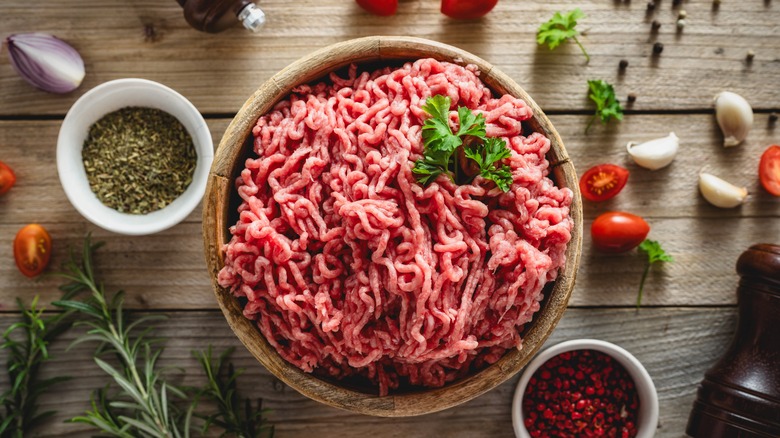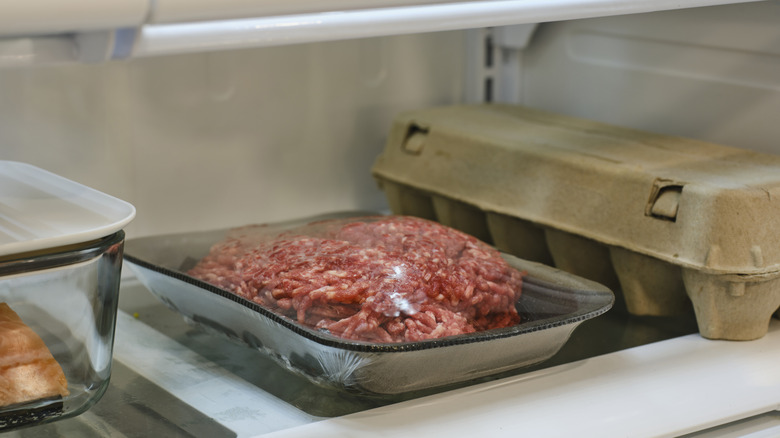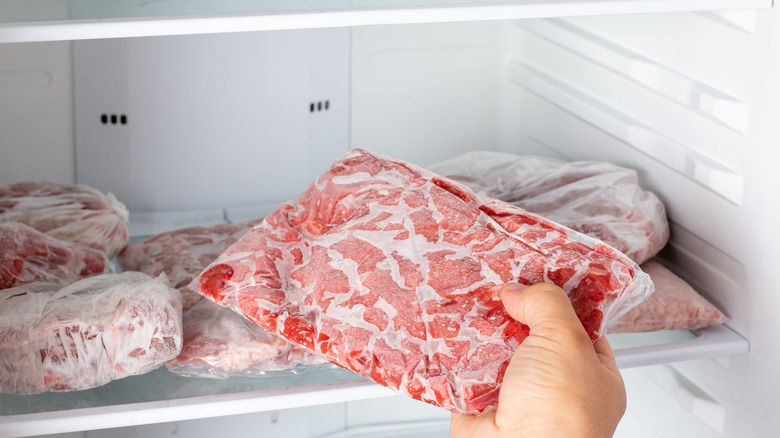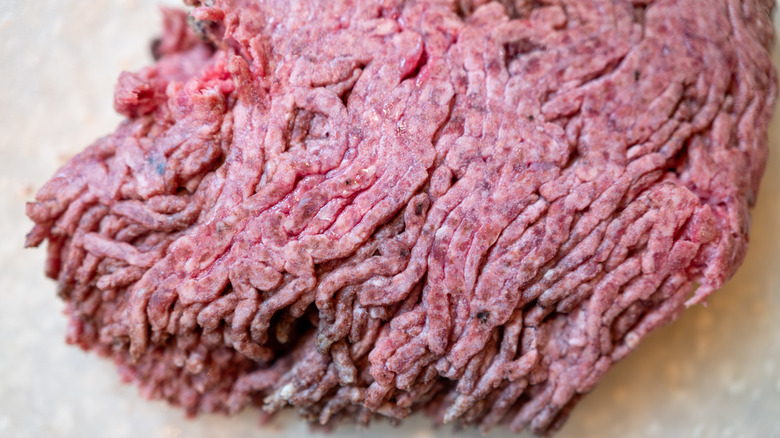Here's How Long Ground Beef Is Safe In Your Fridge, Raw Or Cooked
Statistics tell us that when beef features on the menu in an American home, there's a 60% chance it's ground beef. That's probably because minced cow meat is so much cheaper than whole cuts and many cooks love its versatility which allows for use in a wide range of recipes. So if you've stockpiled this beloved meat, you'll want to know how long you can keep it in the refrigerator before you're ready to prepare your burgers, meatballs, or savory pies. The U.S. Department of Agriculture recommends no more than two days.
Immediately after you get home after buying the best ground beef at the grocery store, the first thing you need to do if you're not cooking the meat right away is prepare it for refrigeration. If unopened, you can leave the meat in its packaging, but place it on top of a plate or dish before putting it on the lowest shelf of your fridge. The goal is to avoid contact between the raw meat (or its juices) and ready-to-eat food in the refrigerator because it can lead to cross-contamination. After two days in the fridge, you should either cook the meat or freeze it.
On the other hand, if you've already cooked your meat and have leftovers, you can treat them just like most other leftovers: store them in an airtight container before putting them in the fridge away from any raw meats. Cooked ground beef will last for a maximum of three to four days.
Why the short shelf life of raw ground beef?
If you're shocked by the two-day refrigeration limit for raw ground beef, we get it. Compared to larger cuts of meat and steaks that can last up to five days in the fridge, two days seems like a very short time. The reason ground beef spoils faster than standard cuts is that it has a higher chance of harboring more bacteria due to how it is processed.
To be clear, all types of meat (and every other food and thing in the environment, for that matter) can carry bacteria. Food safety is achieved by doing our best to either rid our edibles of all harmful microorganisms or at least keep their number as low as possible so they don't reach infectious levels. Refrigeration helps with this because, at 40 degrees Fahrenheit or lower, bacteria multiply very slowly. The recommended refrigeration shelf life of any food, therefore, ensures that in case there are harmful bacteria present, they don't get time to multiply and reach extremely high levels that even adequate cooking will not eliminate.
When it comes to ground beef, the potentially larger amount of bacteria present is due to the mincing process which exposes a larger surface area where more microorganisms can get attached. That means the number of microorganisms on minced meat can reach infectious levels within a shorter time than, say, a large piece of steak which has potentially fewer bacteria due to the smaller exposed surface area.
How to make ground beef last longer
Refrigeration, as we've discussed, only slows down the spoilage process because the 40-degree Fahrenheit temperature still allows for the growth and multiplication of microorganisms. So to ensure both raw and cooked ground meat lasts longer, the solution is freezing.
At 0 degrees Fahrenheit (the required temperature in a freezer) both spoilage-triggering and illness-causing microorganisms cannot multiply because they become dormant. That means your ground meat (and any other food) can stay safe in the freezer indefinitely. The quality can deteriorate though, which is why the USDA recommends using your ground beef within four months of freezing.
To keep ground beef safely frozen, put the meat in a freezer bag with all the air removed before sealing, or wrap it in aluminum foil and stash it in a freezer-safe airtight container before putting it in the freezer. When you're ready to use the meat, avoid the common ground beef mistake of trying to cook it from frozen. Instead, first, defrost it by transferring it to the refrigerator to thaw overnight. Alternatively, for faster defrosting, put the meat in cold water and refresh the water every 30 minutes until fully thawed. You can also microwave the meat in short bursts until fully thawed. After thawing, cook the raw ground meat to an internal temperature of 160 degrees Fahrenheit. For cooked leftover ground beef that has been frozen, follow the same defrosting process then reheat it to 165 degrees Fahrenheit.
Signs that your ground beef is no longer safe to eat
Even with refrigeration or freezing, mistakes can happen, appliances might fail, and blackouts may occur, which can lead to your meat sitting in a less-than-optimum environment even if it's for just a few hours. This can create an opportunity for bacteria to multiply rapidly, leading to spoilage. Therefore, it's important to always be on the lookout for signs of spoilage in your ground beef so you can avoid accidentally eating unsafe meat and falling sick as a result.
Start with a visual inspection of the meat. Fresh raw meat typically has a red hue on the outer surface and is brownish-gray inside. This is due to the reaction of oxygen with the protein called myoglobin; they combine to form oxymyoglobin, which is reddish in color. The inner layers of the meat don't come in contact with as much oxygen and that's why the color remains brownish. But if your ground beef is gray or brown all over, inside and out, that's a sign it's gone bad, so throw it away.
Another sign of spoilage is a slimy texture. When you touch raw or cooked ground beef, it should feel firm. So any sticky meat should be discarded as it's likely already spoiled. Additionally, any foul- or sour-smelling ground beef is a clear sign of being spoiled, so it shouldn't be consumed. Lastly, if you notice any mold growth on your raw or cooked ground beef, discard it immediately.



